超级电容器的参数。word
- 格式:doc
- 大小:8.07 KB
- 文档页数:4
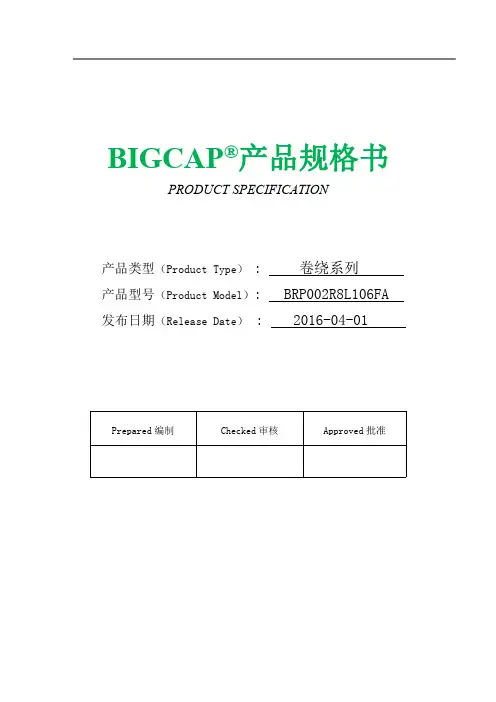
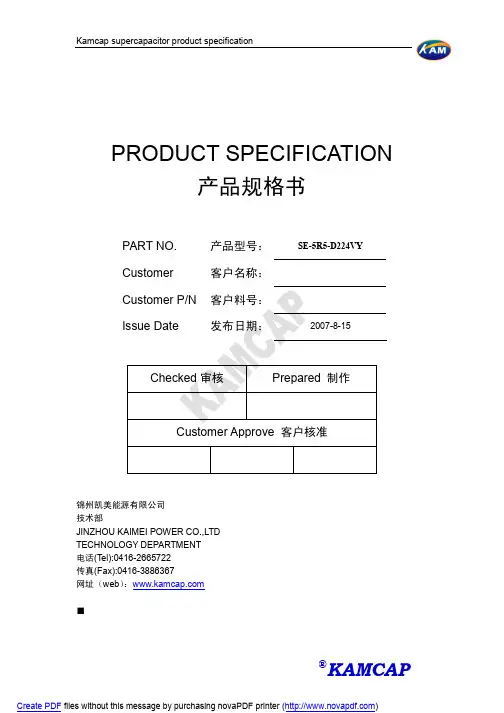
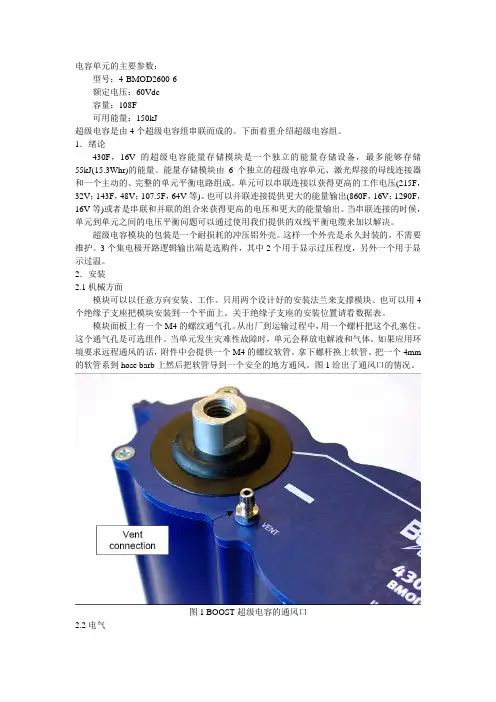
电容单元的主要参数:型号:4-BMOD2600-6额定电压:60Vdc容量:108F可用能量:150kJ超级电容是由4个超级电容组串联而成的。
下面着重介绍超级电容组。
1.绪论430F,16V的超级电容能量存储模块是一个独立的能量存储设备,最多能够存储55kJ(15.3Whr)的能量。
能量存储模块由6个独立的超级电容单元、激光焊接的母线连接器和一个主动的、完整的单元平衡电路组成。
单元可以串联连接以获得更高的工作电压(215F,32V;143F,48V;107.5F,64V等)。
也可以并联连接提供更大的能量输出(860F,16V;1290F,16V等)或者是串联和并联的组合来获得更高的电压和更大的能量输出。
当串联连接的时候,单元到单元之间的电压平衡问题可以通过使用我们提供的双线平衡电缆来加以解决。
超级电容模块的包装是一个耐损耗的冲压铝外壳。
这样一个外壳是永久封装的,不需要维护。
3个集电极开路逻辑输出端是选购件,其中2个用于显示过压程度,另外一个用于显示过温。
2.安装2.1机械方面模块可以以任意方向安装、工作。
只用两个设计好的安装法兰来支撑模块。
也可以用4个绝缘子支座把模块安装到一个平面上。
关于绝缘子支座的安装位置请看数据表。
模块面板上有一个M4的螺纹通气孔。
从出厂到运输过程中,用一个螺杆把这个孔塞住。
这个通气孔是可选组件。
当单元发生灾难性故障时,单元会释放电解液和气体。
如果应用环境要求远程通风的话,附件中会提供一个M4的螺纹软管。
拿下螺杆换上软管。
把一个4mm 的软管系到hose barb上然后把软管导到一个安全的地方通风。
图1给出了通风口的情况。
图1 BOOST超级电容的通风口2.2电气注意:为了避免拉弧或者打火花,能量存储模块在安装过程中应该处于放电状态并断开系统电源。
在运输过程中模块也要放电。
我们推荐首先检查单元的电压确保其电压最小。
为了提供尽可能低的ESR(等效串联电阻),能量存储模块没有装保险。

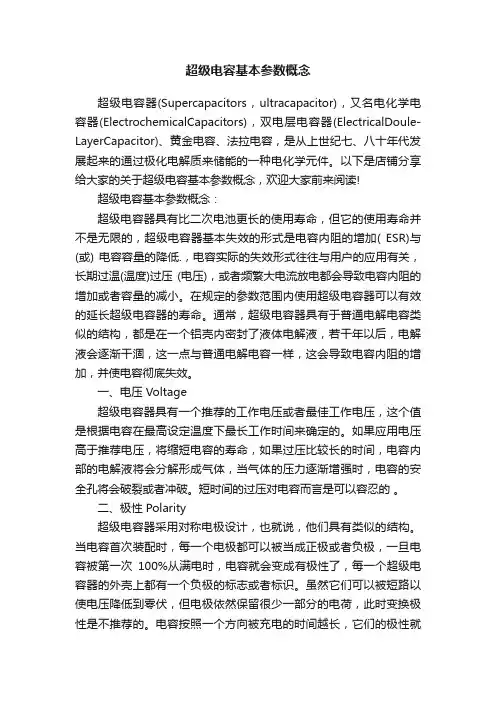
超级电容基本参数概念超级电容器(Supercapacitors,ultracapacitor),又名电化学电容器(ElectrochemicalCapacitors),双电层电容器(ElectricalDoule-LayerCapacitor)、黄金电容、法拉电容,是从上世纪七、八十年代发展起来的通过极化电解质来储能的一种电化学元件。
以下是店铺分享给大家的关于超级电容基本参数概念,欢迎大家前来阅读!超级电容基本参数概念:超级电容器具有比二次电池更长的使用寿命,但它的使用寿命并不是无限的,超级电容器基本失效的形式是电容内阻的增加( ESR)与(或) 电容容量的降低.,电容实际的失效形式往往与用户的应用有关,长期过温(温度)过压 (电压),或者频繁大电流放电都会导致电容内阻的增加或者容量的减小。
在规定的参数范围内使用超级电容器可以有效的延长超级电容器的寿命。
通常,超级电容器具有于普通电解电容类似的结构,都是在一个铝壳内密封了液体电解液,若干年以后,电解液会逐渐干涸,这一点与普通电解电容一样,这会导致电容内阻的增加,并使电容彻底失效。
一、电压 Voltage超级电容器具有一个推荐的工作电压或者最佳工作电压,这个值是根据电容在最高设定温度下最长工作时间来确定的。
如果应用电压高于推荐电压,将缩短电容的寿命,如果过压比较长的时间,电容内部的电解液将会分解形成气体,当气体的压力逐渐增强时,电容的安全孔将会破裂或者冲破。
短时间的过压对电容而言是可以容忍的。
二、极性 Polarity超级电容器采用对称电极设计,也就说,他们具有类似的结构。
当电容首次装配时,每一个电极都可以被当成正极或者负极,一旦电容被第一次100%从满电时,电容就会变成有极性了,每一个超级电容器的外壳上都有一个负极的标志或者标识。
虽然它们可以被短路以使电压降低到零伏,但电极依然保留很少一部分的电荷,此时变换极性是不推荐的。
电容按照一个方向被充电的时间越长,它们的极性就变得越强,如果一个电容长时间按照一个方向充电后变换极性,那么电容的寿命将会被缩短。

产品规格书产品名称: 超级电容器产品型号: WTC5V51F5Z-0720C变更履历表版本修订人变更内容变更日期R21.1 任倩倩1、增加了最大峰值电流(1s) 2021.09.24目录质量声明 (4)1. 适用范围 (5)2. 标准测试条件 (5)3. 一般特性 (5)4. 包装方式 (5)5. 环境性能指标 (6)6. 产品尺寸及外形 (6)7. 命名规则 (7)8. 测试方法 (7)9. 注意事项和使用指导 (9)10. 免责声明 (11)质量声明正确的使用和维护保养才能确保您的电容(或电容系统)长期可靠稳定地运行。
⚫收到产品后,请检查包装是否完好,若包装破损,可能导致产品损坏。
若有损坏,请于五个工作日内联系我司售后或销售人员。
⚫凡不按本说明书规定进行使用或维护保养者,视同放弃保修权利,上海闻亭实业有限公司及其服务站有权不再予以保修,对由此而产生的一切损失也不予以赔偿,但可以根据情况提供相应的有偿服务。
⚫贵司在收到产品及产品说明书后,请于7日内回复。
7日内未回复,我司将视客户承认此产品及产品说明书符合贵司要求。
公司信息地址:上海市黄浦区广西北路528号电话:+86-021-********邮编:200001邮箱:******************网址:1. 适用范围本产品规格书描述了上海闻亭实业有限公司(以下简称闻亭信息)生产的圆柱式超级电容器的产品性能指标。
2. 标准测试条件一般情况下,在标准大气压下,温度15~35 o C,相对湿度在25%~75%条件下进行测试;测试前样品应该在测试温度下放置12 h以上,本规格书的测试条件为标准大气压,温度为25±2 o C,相对湿度为60±15%。
3. 一般特性测试项目规格/条件1 型号WTC5V51F5Z-0720C2 额定容量 1.5 F3 容量偏差-20 % ~ + 80 %4 工作电压 5.5V5 浪涌电压 6.0 V6 标称内阻交流阻抗20 Ω直流阻抗30 Ω7 产品重量8.5±0.05g8 最大峰值电流(1 s) 90mA9 漏电流(24 h) ≤0.02mA10 工作温度-40 ~ 70 o C11 储存温度-40 ~ 85 o C12 循环寿命25ºC,额定电压到半额定电压间循环充放电50万次,|∆C/C|≤30%,ESR≤4倍初始值(25ºC)4. 包装方式产品型号包装数量(只)包装箱尺寸(L×W×H, mm)整箱重量(Kg)每外箱每吸塑盘每内箱每外箱每吸塑盘每内箱WTC5V51F5Z-0720C80 400 1600 331×228×117 485×355×265 16±15. 环境性能指标项目规格/条件1 温度特性+70 o C时|∆C/C|≤30 %,ESR≤规定值(25 o C)-25 o C时|∆C/C|≤50 %,ESR≤4倍初始值(25 o C)2 高温负荷特性+70 o C ± 2加额定电压,1000h后,|∆C/C|≤30%,ESR≤4倍规定值。
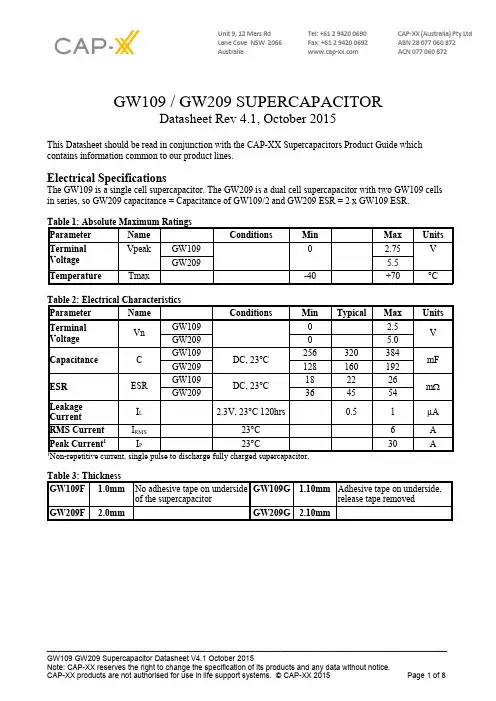
Unit 9, 12 Mars Rd Tel: +61 2 9420 0690 CAP-XX (Australia) Pty LtdLane Cove NSW 2066 Fax: +61 2 9420 0692 ABN 28 077 060 872Australia ACN 077 060 872 GW109 / GW209 SUPERCAPACITORDatasheet Rev 4.1, October 2015This Datasheet should be read in conjunction with the CAP-XX Supercapacitors Product Guide whichcontains information common to our product lines.Electrical SpecificationsThe GW109 is a single cell supercapacitor. The GW209 is a dual cell supercapacitor with two GW109 cellsin series, so GW209 capacitance = Capacitance of GW109/2 and GW209 ESR = 2 x GW109 ESR.Definition of TermsIn its simplest form, the Equivalent Series Resistance (ESR) of a capacitor is the real part of the complex impedance. In the time domain, it can be found by applying a step discharge current to a charged cell as in Fig. 1. In this figure, the supercapacitor is pre-charged and then discharged with a current pulse, I =1A for duration 0.01 secs.Figure 1: Effective capacitance, instantaneous capacitance and ESR for a GW209The ESR is found by dividing the instantaneous voltage step (∆V) by I. In this example = (4.492V-4.447V)/1.03A = 43.7mΩ.The instantaneous capacitance (C i) can be found by taking the inverse of the derivative of the voltage, and multiplying it by I.The effective capacitance for a pulse of duration ∆t n, Ce(∆t n) is found by dividing the total charge removed from the capacitor (∆Q n) by the voltage lost by the capacitor (∆V n). For constant current Ce(∆t n) = I x∆t n/∆V n. Ce increases as the pulse width increases and tends to the DC capacitance value as the pulse width becomes very long (~10 secs). After 2msecs, Fig 1 shows the voltage drop V2ms = (4.447V – 4.414V) =33mV. Therefore Ce(2ms) = 1.03A x 2ms/33mV = 62.4mF. After 10ms, the voltage drop = 4.447 V –4.349V = 98mV. Therefore Ce(10ms) = 1.03A x 10ms/98mV = 105mF. The DC capacitance of a GW209 = 160mF. Note that ∆V, or IR drop, is not included because very little charge is removed from the capacitor during this time. Ce shows the time response of the capacitor and it is useful for predicting circuit behavior in pulsed applications.Measurement of DC CapacitanceFig 2: Measurement of DC Capacitance for a GW209Fig 2 shows the measurement of DC capacitance by drawing a constant 100mA current from a fully charged supercapacitor and measuring the time taken to discharge from 1.5V to 0.5V for a single cell, or from 3V to 1V for a dual cell supercapacitor. In this case, C = 0.1A x 3.406s /2V = 170.3mF, which is well within the 160mF +/- 20% tolerance for a GW209 cell.Measurement of ESRFig 3: Measurement of ESR for a GW209Fig 3 shows DC measurement of ESR by applying a step load current to the supercapacitor and measuring the resulting voltage drop. CAP-XX waits for a delay of 50µs after the step current is applied to ensure the voltage and current have settled. In this case the ESR is measured as 50mV/1.03A = 48.5mΩ.Effective CapacitanceFigure 4: Effective CapacitanceFig 4 shows the effective capacitance for the GW109, GW209 @ 23°C. This shows that for a 1msec PW,you will measure 22.6% of DC capacitance or 63.3mF for a GW109 or 31.6mF for a GW209. At 10msecsyou will measure 60% of the DC capacitance, and at 100msecs you will measure 85% of DC capacitance.Ceffective is a time domain representation of the supercapacitor's frequency response. If, for example, youwere calculating the voltage drop if the supercapacitor was supporting 1A for 10msecs, then you would usethe Ceff(10msecs) = 60% of DC capacitance = 96mF for a GW209, so Vdrop = 1A x ESR + 1A x duration/C= 1A x 45mΩ + 1A x 10ms / 96mF = 149mV. The next section on pulse response shows how the effective capacitance is sufficient for even short pulse widths.Pulse ResponseFig 5 shows that the GW209supercapacitor does an excellent jobsupporting a GPRS class 10 pulsetrain, drawing 1.8A for 1.1ms at25% duty cycle. The source iscurrent limited to 0.6A and thesupercapacitor provides the 1.2Adifference to achieve the peakcurrent. At first glance the freqresponse of Fig 8 indicates thesupercapacacitor would not supporta 1ms pulse, but the Ceff of 31.6mFcoupled with the low ESR supportsthis pulse train with only ~117mVdroop in the supply rail. Fig 5: GW209 Pulse Response with GPRS Class 10 Pulse TrainDC Capacitance variation with temperatureFigure 6: Capacitance change with temperatureFig 6 shows that DC capacitance is approximately constant with temperature.ESR variation with temperatureFigure 7: ESR change with temperatureFig 7 shows that ESR at -40°C is ~2.2 x ESR at room temp, and that ESR at 70ºC is ~0.82 x ESR at room temperature.Frequency ResponseFig 8: Frequency Response of Impedance (biased at 2.3V with a 50mV test signal)Fig 9: Frequency Response of ESR, Capacitance & InductanceFig 8 shows the supercapacitor behaves as an ideal capacitor until approx 10 Hz when the magnitude no longer rolls off proportionally to 1/freq and the phase crosses -45°. Performance of supercapacitors with frequency is complex and the best predictor of performance is Fig 4 showing effective capacitance as a function of pulsewidth.Leakage CurrentFig 10: Leakage CurrentFig 10 shows the leakage current for GW109 at room temperature. The leakage current decays over time and the equilibrium value leakage current will be reached after ~120hrs at room temperature. The typical equilibrium leakage current is 0.5µA at room temperature. At 70°C leakage current will be ~5µA. Charge CurrentFig 11: Charging an GW109 with low currentThe corollary to the slow decay in leakage currents shown in Fig 10 is that charging a supercapacitor at very low currents takes longer than theory predicts. At higher charge currents, the charge rate is as theory predicts. For example, it should take 0.32F x 2.3V / 0.00002A = 10 hrs to charge a 0.16F supercapacitor to 2.3V at20µA, but Fig 11 shows it took 14hrs. At 100µA charging occurs at a rate close to the theoretical rate.RMS CurrentFig 12: Temperature rise in GW209 with RMS currentContinuous current flow into/out of the supercap will cause self heating, which limits the maximum continuous current the supercapacitor can handle. This is measured by a current square wave with 50% duty cycle, charging the supercapacitor to rated voltage at a constant current, and then discharging the supercapacitor to half rated voltage at the same constant current value. For a square wave with 50% duty cycle, the RMS current is the same as the current amplitude. Fig 12 shows the increase in temperature as a function of RMS current. From this, the maximum RMS current in an application can be calculated, for example, if the ambient temperature is 40︒C, and the maximum desired temperature for the supercapacitor is 70︒C, then the maximum RMS current should be limited to 4.5A, which causes a 30︒C temperature increase. CAP-XX Supercapacitors Product GuideRefer to the package drawings in the CAP-XX Supercapacitors Product Guide for detailed information of the product’s dimensions, PCB landing placements, active areas and electrical connections.Refer to the CAP-XX Supercapacitors Product Guide for information on endurance and shelf life, transportation and storage, assembly and soldering, safety and RoHS/EREACH certification.。
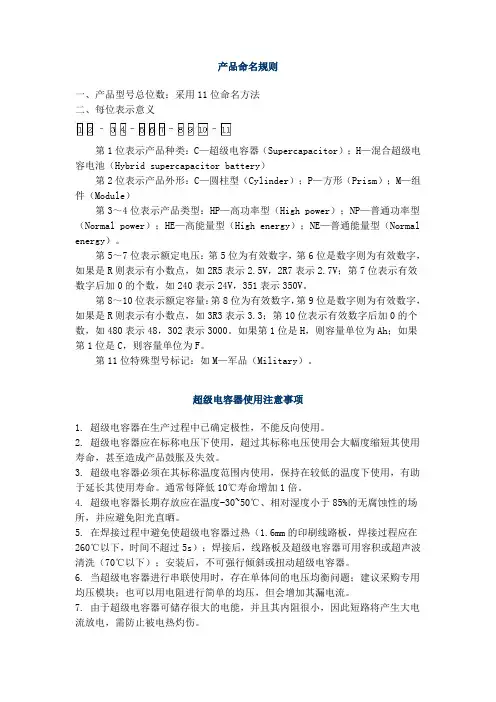
产品命名规则一、产品型号总位数:采用11位命名方法二、每位表示意义第1位表示产品种类:C—超级电容器(Supercapacitor);H—混合超级电容电池(Hybrid supercapacitor battery)第2位表示产品外形:C—圆柱型(Cylinder);P—方形(Prism);M—组件(Module)第3~4位表示产品类型:HP—高功率型(High power);NP—普通功率型(Normal power);HE—高能量型(High energy);NE—普通能量型(Normal energy)。
第5~7位表示额定电压:第5位为有效数字,第6位是数字则为有效数字,如果是R则表示有小数点,如2R5表示2.5V,2R7表示2.7V;第7位表示有效数字后加0的个数,如240表示24V,351表示350V。
第8~10位表示额定容量:第8位为有效数字,第9位是数字则为有效数字,如果是R则表示有小数点,如3R3表示3.3;第10位表示有效数字后加0的个数,如480表示48,302表示3000。
如果第1位是H,则容量单位为Ah;如果第1位是C,则容量单位为F。
第11位特殊型号标记:如M—军品(Military)。
超级电容器使用注意事项1. 超级电容器在生产过程中已确定极性,不能反向使用。
2. 超级电容器应在标称电压下使用,超过其标称电压使用会大幅度缩短其使用寿命,甚至造成产品鼓胀及失效。
3. 超级电容器必须在其标称温度范围内使用,保持在较低的温度下使用,有助于延长其使用寿命。
通常每降低10℃寿命增加1倍。
4. 超级电容器长期存放应在温度-30~50℃、相对湿度小于85%的无腐蚀性的场所,并应避免阳光直晒。
5. 在焊接过程中避免使超级电容器过热(1.6mm的印刷线路板,焊接过程应在260℃以下,时间不超过5s);焊接后,线路板及超级电容器可用容积或超声波清洗(70℃以下);安装后,不可强行倾斜或扭动超级电容器。
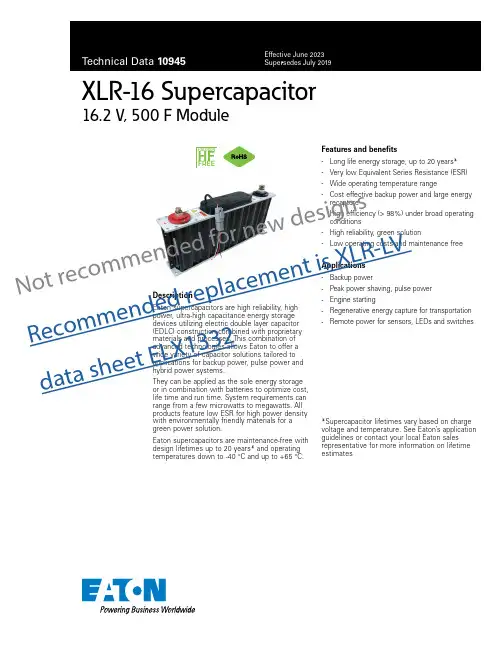
XLR-16 Supercapacitor16.2 V, 500 F ModuleFeatures and benefits• Long life energy storage, up to 20 years*• Very low Equivalent Series Resistance (ESR)• Wide operating temperature range•Cost effective backup power and large energyrecapture• High efficiency (> 98%) under broad operating conditions• High reliability, green solution•Low operating costs and maintenance freeApplications• Backup power• Peak power shaving, pulse power • Engine starting• Regenerative energy capture for transportation •Remote power for sensors, LEDs and switchesDescriptionEaton supercapacitors are high reliability, highpower, ultra-high capacitance energy storage devices utilizing electric double layer capacitor (EDLC) construction combined with proprietary materials and processes. This combination of advanced technologies allows Eaton to offer a wide variety of capacitor solutions tailored to applications for backup power, pulse power and hybrid power systems.They can be applied as the sole energy storage or in combination with batteries to optimize cost, life time and run time. System requirements can range from a few microwatts to megawatts. All products feature low ESR for high power density with environmentally friendly materials for a green power solution.Eaton supercapacitors are maintenance-free with design lifetimes up to 20 years* and operating temperatures down to -40 °C and up to +65 °C.*Supercapacitor lifetimes vary based on charge voltage and temperature. See Eaton’s application guidelines or contact your local Eaton sales representative for more information on lifetime estimatesHALOGENHF FREEN o t r e c o m m e nd e d f o rn e w de s i g n s R e c o m m e n d e d r e p l a c e m e n t i s X L R-L V da t a s h e e t E L X 13322Technical Data 10945Effective June 2023XLR-16 Supercapacitor 16.2 V, 500 F Module/electronicsRatingsCapacitance500 F Maximum operating voltage 16.2 V Surge voltage17.1 VCapacitance tolerance-5% to +20% Operating temperature range-40 °C to +65 °CSpecificationsCapacitance 1 (F)Part numberMaximumworking voltage (V) Maximum initial ESR 1 (mΩ)Leakage current 1, 2 (mA)Stored energy 3 (Wh)Peak power 5 (kW)Pulse current 4(A)Continuouscurrent 6 (A)500XLR-16R2507-R 16.2 1.7518.238.62189.2122PerformanceParameterCapacitance Change (% of initial value)ESR(% of initial maximum value)Lifetime: (1500 hours at maximum temperature and voltage)≤ 20%≤ 200%Charge/Discharge Cycles 7 (1,000,000 at +25 °C)≤ 20%≤ 200%Storage: (3 years, uncharged, < +35 °C)≤ 5%≤ 10%1.Capacitance, Equivalent Series Resistance (ESR) and Leakage current are measured according to IEC62391-1 with current in milliamps (mA) = 8 x C x V.2. Leakage current at +20 °C after 72 hour charge and hold at rated voltage.3. Stored Energy (Wh) = 0.5 x C x V 2 36004. Pulse current for 1 second from full rate voltage to half voltage. (A) = 0.5 x V x C 1 + ESR x C5. Peak Power (W) = V 2 4x ESR6. Continuous current with a 15 °C temperature rise.7. Cycling between rated voltage and half voltage, 3 second rest at +25 °C.Safety and CertificationsAgency information UL810a (cells)Shock and vibrationsSAE J2464 & J2380Environmental RoHS, HFShippingNo restrictions, per UN3499 ship with shorting wireN o tr ec o m m e nd ed f o rn e w de s i g n s R ec o m me n d e d re p l a c e m e n t i s X L R-L V d a ta s h e e t EL X 1332EatonElectronics Division 1000 Eaton Boulevard Cleveland, OH 44122United States/electronics © 2023 EatonAll Rights Reserved Printed in USAPublication No. 10945June 2023Technical Data 10945Effective June 2023XLR-16 Supercapacitor 16.2 V, 500 F Module Life Support Policy: Eaton does not authorize the use of any of its products for use in life support devices or systems without the express writtenapproval of an officer of the Company. Life support systems are devices which support or sustain life, and whose failure to perform, when properly used in accordance with instructions for use provided in the labeling, can be reasonably expected to result in significant injury to the user.Eaton reserves the right, without notice, to change design or construction of any products and to discontinue or limit distribution of any products. Eaton also reserves the right to change or update, without notice, any technical information contained in this bulletin.Eaton is a registered trademark.All other trademarks are property of their respective owners.Follow us on social media to get thelatest product and support information.Dimensions (mm)Part Marking• Manufacturer • Capacitance (F)• Module operating voltage (V) •Family code or part numberPart numbering systemXLR–16R2507-RFamily codeVoltage (V)R = decimal Capacitance (μF)ValueMultiplierStandard productXLR=Family Code 16R2 = 16.2 V Example 507 = 5.0x107μF or 500 FPackaging information•Standard packaging: Bulk, 1 piece per boxT ypical Mass: 5.7 kgN o t r e c o m m e n d e d f o r n e w de s i g n s R e c o m m e n d e d r e p l a c e m e n t i s X L R -L V da t a s h e e t E L X 1332。
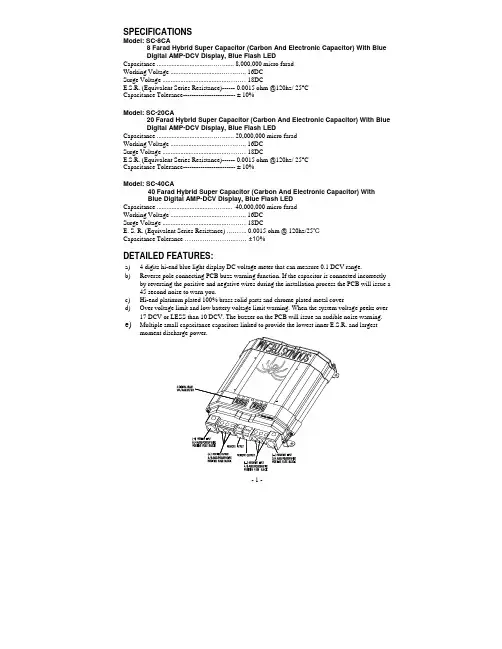
SPECIFICATIONSModel: SC-8CA8 Farad Hybrid Super Capacitor (Carbon And Electronic Capacitor) With BlueDigital AMP-DCV Display, Blue Flash LEDCapacitance .................................……...... 8,000,000 micro faradWorking Voltage ...............................…….….. 16DCSurge Voltage .......................................……… 18DCE.S.R. (Equivalent Series Resistance)------ 0.0015 ohm @120hz/ 25°CCapacitance Tolerance------------------------ ± 10%Model: SC-20CA20 Farad Hybrid Super Capacitor (Carbon And Electronic Capacitor) With BlueDigital AMP-DCV Display, Blue Flash LEDCapacitance .................................……...... 20,000,000 micro faradWorking Voltage ...............................…….….. 16DCSurge Voltage .......................................……… 18DCE.S.R. (Equivalent Series Resistance)------ 0.0015 ohm @120hz/ 25°CCapacitance Tolerance------------------------ ± 10%Model: SC-40CA40 Farad Hybrid Super Capacitor (Carbon And Electronic Capacitor) WithBlue Digital AMP-DCV Display, Blue Flash LEDCapacitance .................................……..... 40,000,000 micro faradWorking Voltage ...............................…….….. 16DCSurge Voltage .......................................……… 18DCE. S. R. (Equivalent Series Resistance) ..…….. 0.0015 ohm @ 120hz/25℃Capacitance Tolerance (10)DETAILED FEATURES:a) 4 digits hi-end blue light display DC voltage meter that can measure 0.1 DCV range.b)Reverse pole connecting PCB buzz warning function. If the capacitor is connected incorrectlyby reversing the positive and negative wires during the installation process the PCB will issue a45 second noise to warn you.c)Hi-end platinum plated 100% brass solid parts and chrome plated metal coverd)Over voltage limit and low battery voltage limit warning. When the system voltage peeks over17 DCV or LESS than 10 DCV. The buzzer on the PCB will issue an audible noise warning.e)Multiple small capacitance capacitors linked to provide the lowest inner E.S.R. and largest- 1 -INSTALLATION AND MOUNTING:You must first attach the mounting tabs to the capacitor before mounting it. Use the supplied hardware shown in the picture to the right. Notice the small mounting screw hole in the capacitor chassis.CHARGING THE CAPACITOR AND WIRING:The capacitor must be charged before connecting the Power and Ground cables to the capacitor. Failure to charge the capacitor will result in a large spark generated from the rapid inflow of current.- 2 -To Charge the capacitor:1. Make Capacitor positive terminal connections with amplifier andtighten the bolt. Do not over-tighten the bolts!Caution:Stripped terminals are not covered under the capacitor’s warranty.2. Connect the ground cable with battery, amplifier, then refer to theattached drawing.3. Place the supplied charging bulb between positive terminal of thecapacitor and the battery’s positive terminal. Do this for 2 ~ 3minutes or until the charging bulb goes out.Caution: The charging bulb will get hot!4. Immediately take out the charging bulb from the connecting wire afterthe charging process. And connect the positive cable of the batterydirectly to the positive terminal on the capacitor. DISCHARGING THE CAPACITOR:When you want to take out the capacitor after you finish the installation process from original car audio system. You must do discharge process when you want to move the capacitor. It will be safe to release the power of the capacitor.To Discharge the capacitor: With battery power disconnected, place the light bulb or resistor across the capacitor’s positive and negative terminals until light goes out or for three minutes if using a resistor.- 3 -Multiple Capacitor Wiring Diagram:WARNING!!THIS POWER CAPACITOR MAY EXPLODE AND CAUSE SERIOUS INJURY IF ABUSED OR CONNECTED IMPROPERLY. PLEASE REFER TO THE INSTRUCTIONS CONTAINED IN THIS MANUAL FOR CORRECT OUNTING, CHARGING/DISCHARGING AND WIRING CONNECTION FOR THIS CAPAPCITOR PRIOR TO INSTALLATION.LIMITED WARRANTYOne Year Warranty from the date of purchase.- 4 -。
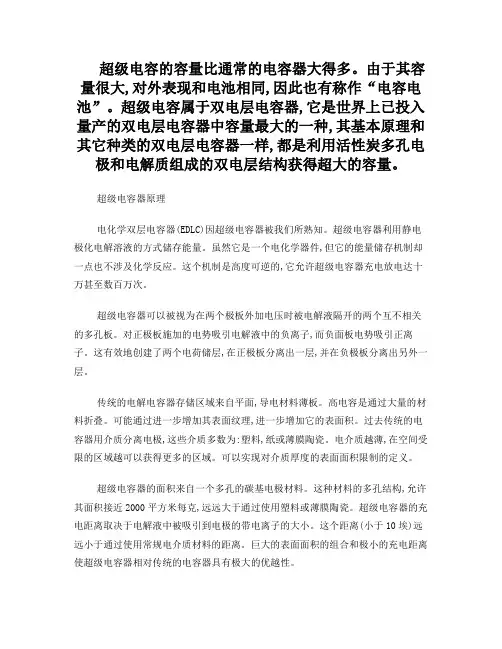
超级电容的容量比通常的电容器大得多。
由于其容量很大,对外表现和电池相同,因此也有称作“电容电池”。
超级电容属于双电层电容器,它是世界上已投入量产的双电层电容器中容量最大的一种,其基本原理和其它种类的双电层电容器一样,都是利用活性炭多孔电极和电解质组成的双电层结构获得超大的容量。
超级电容器原理电化学双层电容器(EDLC)因超级电容器被我们所熟知。
超级电容器利用静电极化电解溶液的方式储存能量。
虽然它是一个电化学器件,但它的能量储存机制却一点也不涉及化学反应。
这个机制是高度可逆的,它允许超级电容器充电放电达十万甚至数百万次。
超级电容器可以被视为在两个极板外加电压时被电解液隔开的两个互不相关的多孔板。
对正极板施加的电势吸引电解液中的负离子,而负面板电势吸引正离子。
这有效地创建了两个电荷储层,在正极板分离出一层,并在负极板分离出另外一层。
传统的电解电容器存储区域来自平面,导电材料薄板。
高电容是通过大量的材料折叠。
可能通过进一步增加其表面纹理,进一步增加它的表面积。
过去传统的电容器用介质分离电极,这些介质多数为:塑料,纸或薄膜陶瓷。
电介质越薄,在空间受限的区域越可以获得更多的区域。
可以实现对介质厚度的表面面积限制的定义。
超级电容器的面积来自一个多孔的碳基电极材料。
这种材料的多孔结构,允许其面积接近2000平方米每克,远远大于通过使用塑料或薄膜陶瓷。
超级电容器的充电距离取决于电解液中被吸引到电极的带电离子的大小。
这个距离(小于10埃)远远小于通过使用常规电介质材料的距离。
巨大的表面面积的组合和极小的充电距离使超级电容器相对传统的电容器具有极大的优越性。
超级电容器内部结构超级电容器结构上的具体细节依赖于对超级电容器的应用和使用。
由于制造商或特定的应用需求,这些材料可能略有不同。
所有超级电容器的共性是,他们都包含一个正极,一个负极,及这两个电极之间的隔膜,电解液填补由这两个电极和隔膜分离出来的两个的孔隙。
图1. 超级电容器结构超级电容器的部件从产品到产品可以有所不同。
超级电容是近几年才批量生产的一种无源器件,介于电池与普通电容之间,具有电容的大电流快速充放电特性,同时也有电池的储能特性,并且重复使用寿命长,放电时利用移动导体间的电子(而不依靠化学反应)释放电流,从而为设备提供电源。
超级电容的特性一、超级电容器特性:a. 体积小,容量大,电容量比同体积电解电容容量大30~40倍;b. 充电速度快,10秒内达到额定容量的95%;c. 充放电能力强;d. 失效开路,过电压不击穿,安全可靠;e. 超长寿命,可长达40万小时以上;f. 充放电线路简单,无需充电电池那样的充电电路,真正免维护;g. 电压类型:2.7v---12.0vh. 容量范围:0.1F--1000F二、超级电容与电池比较,有如下特性:a.超低串联等效电阻(LOW ESR),功率密度(Power Density)是锂离子电池的数十倍以上,适合大电流放电,(一枚4.7F电容能释放瞬间电流18A以上)。
b. 超长寿命,充放电大于50万次,是Li-Ion电池的500倍,是Ni-MH和Ni-Cd电池的1000倍,如果对超级电容每天充放电20次,连续使用可达68年。
c. 可以大电流充电,充放电时间短,对充电电路要求简单,无记忆效应。
d. 免维护,可密封。
e.温度范围宽-40℃~+70℃,一般电池是-20℃~60℃超级电容器又称超大容量电容器、金电容、黄金电容、储能电容、法拉电容、电化学电容器或双电层电容器(英文名称为EDLC,即ElectricDoubleLayerCapacitors),是靠极化电解液来存储电能的新型电化学装置。
它是近十几年随着材料科学的突破而出现的新型功率型储能元件,其批量生产不过几年时间。
超级电容器自面市以来,全球需求量快速扩大,已成为化学电源领域内新的产业亮点。
超级电容器在电动汽车、混合燃料汽车、特殊载重汽车、电力、铁路、通信、国防、消费性电子产品等众多领域有着巨大的应用价值和市场潜力,被世界各国所广泛关注。
HCCCAP EDLCsSPECIFICATION HCCCAP超级电容规格书【PRODUCT】产品:HCCCAP EDLCs【MODEL】型号:HCAP-C2R7166北京合众汇能科技有限公司HCC ENERGY TECH.Co.,LTD.TEL:+86-10-82897371email:*******************1.适用范围Scope本产品规格书对产品的性能,测试方法进行了规范,作为技术确认的参照。
数据参数仅作参考,不同批次与不同时间生产的实际产品参数可能会有所变化,以实际收到的产品为准,确切参数请及时向厂家核实。
This specification describes,the product property and test method,and should serve as the reference for technical assurance.These data is only for reference,actual product data in different batches and different times may vary,with the actual receipt of the product as a prospective,exact parameters,please promptly to the manufacturers to verify.2.一般特性General Specifications1)产品性能Features●高能量密度Ultra High Energy Density●长寿命Long Usage Life●高低温性能Excellent Performance at High and Low Temperatures●环保Environmental Friendly●免维护Maintenance Free2)产品应用范围Typical Applications●智能电网及其它配套设备Smart grid and other ancillary equipment●智能三表Intelligent Three-ammeters●集中器Concentrator●故障指示器Fault Indicator●混合动力汽车HEV/EV●太阳能/风能Solar/Wind energy●电机启动Motor drive●后备电源Memory Back up Batteries3)标准测试条件在标准大气压,温度5~35℃,相对湿度小于85%条件下进行测试;本规格书标准测试条件为标准大气压,温度25℃,相对湿度小于60%。
额定电容量, (DCC, 25℃) C R1F DCC 恒流放电(0.5A)容量偏差率-10%~+50%容量0.75mAh额定电压, (25℃) V R 2.7V尖充电压, Vsurge 2.85V额定电流(25℃)0.25A 5 秒放电至1/2 V R最大电流(25℃)>1.0A 1 秒放电至1/2 V R储存能量(at V R) E 3.6J(0.001Wh) E = 1/2 C V 2R质量比 1.3Wh/kg比能量(at V R)体积比 2.0Wh/l质量比9kW/kg 比功率( 在合适负载下)体积比14kW/l 功率密度是在放电时一半能量为输出电能一半能量转化为内部耗热情况下计算得到的ESR AC (1kHz)200mΩ内阻(ESR)ESR DC(0.3A)250mΩ50mHz尺寸(不含引出端子)ø 8 x 10体积(不含引出端子) v0.5ml质量m0.8g工作温度范围Top-40 ~ 60 ℃与初始测量值比较,| ∆C |<20% ,储存温度范围(at 0V) Tst-40 ~ 70 ℃最大漏电电流, L C (12h, 25℃)0.5mA寿命(at V R, 25℃)90000h 寿命(at V R, 70℃)1000h 循环寿命(25℃)500,000与初始测量值比较,| ∆C |< 30% ,ESR < 2 倍,LC < 标定值1 循环: 20s充电至V R, 恒压10s, 20s充电至1/2V R, 静置10s额定电容量, (DCC, 25℃) C R 2 F DCC 恒流放电(0.5A)容量偏差率-10%~+30%容量 1.5mAh额定电压, (25℃) V R 2.7V尖充电压, Vsurge 2.85V额定电流(25℃)0.52A 5 秒放电至1/2 V R最大电流(25℃)>2.2A 1 秒放电至1/2 V R储存能量(at V R) E7.3J(0.002Wh) E = 1/2 C V 2R质量比 1.7Wh/kg比能量(at V R)体积比 2.7Wh/l质量比7.6kW/kg 比功率( 在合适负载下)体积比12kW/l 功率密度是在放电时一半能量为输出电能一半能量转化为内部耗热情况下计算得到的ESR AC (1kHz)150mΩ内阻(ESR)ESR DC(0.3A)200mΩ50mHz尺寸(不含引出端子)ø 8 x 15体积(不含引出端子) v0.75ml质量m 1.2g工作温度范围Top-40 ~ 60 ℃与初始测量值比较,| ∆C |<20% ,储存温度范围(at 0V) Tst-40 ~ 70 ℃最大漏电电流, L C (12h, 25℃)0.5mA寿命(at V R, 25℃)90000h 寿命(at V R, 70℃)1000h 循环寿命(25℃)500,000与初始测量值比较,| ∆C |< 30% ,ESR < 2 倍,LC < 标定值1 循环: 20s充电至V R, 恒压10s, 20s充电至1/2V R, 静置10s额定电容量, (DCC, 25℃) C R 3 F DCC 恒流放电容量偏差率-10%~+30%容量 2.3mAh额定电压, (25℃) V R 2.7V尖充电压, Vsurge 2.85V额定电流(25℃)0.74A 5 秒放电至1/2 V R 最大电流(25℃)>2.8A 1 秒放电至1/2 V R 储存能量(at V R) E11J(0.003Wh) E = 1/2 C V 2R质量比2Wh/kg比能量(at V R)体积比3Wh/l质量比8kW/kg 比功率( 在合适负载下)体积比12kW/l 功率密度是在放电时一半能量为输出电能一半能量转化为ESR AC (1kHz)100mΩ内阻(ESR)ESR DC(0.3A)150mΩ50mHz尺寸(不含引出端子)ø 8 x 20体积(不含引出端子) v1ml质量m 1.5g工作温度范围Top-40 ~ 60 ℃与初始测量值比较,|∆C |< 20% ,储存温度范围(at 0V) Tst-40 ~ 70 ℃最大漏电电流, L C (12h, 25℃)1mA寿命(at V R, 25℃)90000h 寿命(at V R, 70℃)1000h 循环寿命(25℃)500,000与初始测量值比较,| ∆C |< 30% , ESR < 2 倍,LC < 标定值1 循环: 20s充电至V R, 恒压10s, 20s 充电至1/2V R, 静置额定电容量, (DCC, 25℃) C R 5 F DCC 恒流放电(1A)容量偏差率-10%~+30%容量 3.75mAh额定电压, (25℃) V R 2.7V尖充电压, Vsurge 2.85V额定电流(25℃) 1.2A 5 秒放电至1/2 V R 最大电流(25℃)>4.5A 1 秒放电至1/2 V R 储存能量(at V R) E18J(0.005Wh) E = 1/2 C V 2R质量比 2.3Wh/kg比能量(at V R)体积比 2.1Wh/l质量比8.3kW/kg 比功率( 在合适负载下)体积比7.6kW/l 功率密度是在放电时一半能量为输出电能一半能量转化为内部耗热情况下计算得到的ESR AC (1kHz)60mΩ内阻(ESR)ESR DC(0.5A)100mΩ50mHz尺寸(不含引出端子)ø 10 x 20体积(不含引出端子) v 2.4ml质量m 2.2g工作温度范围Top-40 ~ 60 ℃与初始测量值比较,| ∆C |<20% ,储存温度范围(at 0V) Tst-40 ~ 70 ℃最大漏电电流, L C (12h, 25℃) 1.2mA寿命(at V R, 25℃)90000h 寿命(at V R, 70℃)1000h 循环寿命(25℃)500,000与初始测量值比较,| ∆C |< 30% ,ESR < 2 倍,LC < 标定值1 循环: 20s充电至V R, 恒压10s, 20s充电至1/2V R, 静置10s额定电容量, (DCC, 25℃) C R10F DCC 恒流放电(2A)容量偏差率-10%~+30%容量7.5mAh额定电压, (25℃) V R 2.7V尖充电压, Vsurge 2.85V额定电流(25℃) 2.3A 5 秒放电至1/2 V R 最大电流(25℃)>6.8A 1 秒放电至1/2 V R 储存能量(at V R) E36J(0.01Wh) E = 1/2 C V 2R质量比 3.1Wh/kg比能量(at V R)体积比 4.3Wh/l质量比 5.7kW/kg 比功率( 在合适负载下)体积比7.9kW/l 功率密度是在放电时一半能量为输出电能一半能量转化为内部耗热情况ESR AC (1kHz)80mΩ内阻(ESR)ESR DC(1A)100mΩ50mHz尺寸(不含引出端子)ø 10 x 30体积(不含引出端子) v 2.3ml质量m 3.2g工作温度范围Top-40 ~ 60 ℃与初始测量值比较,| ∆C |< 20% ,ESR< 2 倍,25℃储存温度范围(at 0V) Tst-40 ~ 70 ℃最大漏电电流, L C (12h, 25℃) 1.5mA寿命(at V R, 25℃)90000h 寿命(at V R, 70℃)1000h 循环寿命(25℃)500,000与初始测量值比较,| ∆C |< 30% ,ESR < 2 倍,LC < 标定值1 循环: 20s充电至V R, 恒压10s, 20s充电至1/2V R, 静置10sHCC EDLCs HCC 超级电容器数据手册 HCC10F/2.7V额定电容量, (DCC, 25℃) C R25 F DCC 恒流放电(5A)容量偏差率-10%~+30%容量18mAh额定电压, (25℃) V R 2.7V尖充电压, Vsurge 2.85V额定电流(25℃) 6.7A 5 秒放电至1/2 V R 最大电流(25℃)>21A 1 秒放电至1/2 V R 储存能量(at V R) E91J(0.025Wh) E = 1/2 C V 2R质量比 2.8Wh/kg比能量(at V R)体积比 4.2Wh/l质量比 5.0kW/kg 比功率( 在合适负载下)体积比7.6kW/l 功率密度是在放电时一半能量为输出电能一半能量转化为内部耗热情况下计算得到的ESR AC (1kHz)30mΩ内阻(ESR)ESR DC(5A)40mΩ50mHz尺寸(不含引出端子)ø 16 x 30体积(不含引出端子) v6ml质量m9g工作温度范围Top-40 ~ 60 ℃与初始测量值比较,| ∆C |<20% ,储存温度范围(at 0V) Tst-40 ~ 70 ℃最大漏电电流, L C (12h, 25℃) 1.6mA寿命(at V R, 25℃)90000h 寿命(at V R, 70℃)1000h 循环寿命(25℃)500,000与初始测量值比较,| ∆C |<30% ,ESR < 2 倍,LC < 标定值1 循环: 20s充电至V R, 恒压10s, 20s充电至1/2V R, 静置10sHCC EDLCs HCC 超级电容器数据手册 HCC25F/2.7V额定电容量, (DCC, 25℃) C R30F DCC 恒流放电(10A)容量偏差率-10%~+30%容量23mAh额定电压, (25℃) V R 2.7V尖充电压, Vsurge 2.85V额定电流(25℃)7A 5 秒放电至1/2 V R最大电流(25℃)>21A 1 秒放电至1/2 V R储存能量(at V R) E109J(0.03Wh) E = 1/2 C V 2R质量比2Wh/kg比能量(at V R)体积比 2.7Wh/kg质量比 4.1kW/kg 比功率( 在合适负载下)体积比 5.3kW/kg 功率密度是在放电时一半能量为输出电能一半能量转化为内部耗热情况下计算得到的ESR AC (1kHz)25mΩ内阻(ESR)ESR DC (5A)30mΩ50mHz尺寸(不含引出端子)ø 22 x 30体积(不含引出端子) v11.4ml质量m15g工作温度范围Top-40 ~ 60 ℃与初始测量值比较,| ∆C |<20% ,储存温度范围(at 0V) Tst-40 ~ 70 ℃最大漏电电流, L C (12h, 25℃) 1.6mA寿命(at V R, 25℃)90000h 寿命(at V R, 70℃)1000h 循环寿命(25℃)500,000与初始测量值比较,| ∆C |< 30% ,ESR < 2 倍,LC < 标定值1 循环: 20s充电至V R, 恒压10s, 20s充电至1/2V R, 静置10sHCC EDLCs HCC 超级电容器数据手册 HCC30F/2.7V额定电容量, (DCC, 25℃) C R60F DCC 恒流放电(10A)容量偏差率-10%~+30%容量45mAh额定电压, (25℃) V R 2.7V尖充电压, Vsurge 2.85V额定电流(25℃)12.5A 5 秒放电至1/2 V R最大电流(25℃)>33A 1 秒放电至1/2 V R储存能量(at V R) E219J(0.06Wh) E = 1/2 C V 2R质量比 2.4Wh/kg比能量(at V R)体积比 3.2Wh/kg质量比 2.9kW/kg 比功率( 在合适负载下)体积比 3.8kW/kg 功率密度是在放电时一半能量为输出电能一半能量转化为内部耗热情况下计算得到的ESR AC (1kHz)20mΩ内阻(ESR)ESR DC (10A)25mΩ50mHz尺寸(不含引出端子)ø 22 x 50体积(不含引出端子) v19ml质量m25g工作温度范围Top-40 ~ 60 ℃与初始测量值比较,| ∆C |<20% ,储存温度范围(at 0V) Tst-40 ~ 70 ℃最大漏电电流, L C (12h, 25℃) 1.7mA寿命(at V R, 25℃)90000h 寿命(at V R, 70℃)1000h 循环寿命(25℃)500,000与初始测量值比较,| ∆C |< 30% ,ESR < 2 倍,LC < 标定值1 循环: 20s充电至V R, 恒压10s, 20s充电至1/2V R, 静置10s额定电容量, (DCC, 25℃) C R100F DCC 恒流放电(10A)容量偏差率-10%~+30%容量75mAh额定电压, (25℃) V R 2.7V尖充电压, Vsurge 2.85V额定电流(25℃)12.5A 5 秒放电至1/2 V R最大电流(25℃)>33A 1 秒放电至1/2 V R储存能量(at V R) E365J(0.1Wh) E = 1/2 C V 2R质量比 3.6Wh/kg比能量(at V R)体积比 4.2Wh/kg质量比 3.2kW/kg 比功率( 在合适负载下)体积比 4.0kW/kg 功率密度是在放电时一半能量为输出电能一半能量转化为内部耗热情况下计算得到的ESR AC (1kHz)15mΩ内阻(ESR)ESR DC (10A)20mΩ50mHz尺寸(不含引出端子)ø 25 x46体积(不含引出端子) v22.6ml质量m28g工作温度范围Top-40 ~ 60 ℃与初始测量值比较,| ∆C |<20% ,储存温度范围(at 0V) Tst-40 ~ 70 ℃最大漏电电流, L C (12h, 25℃) 2 mA寿命(at V R, 25℃)90000h 寿命(at V R, 70℃)1000h 循环寿命(25℃)500,000与初始测量值比较,| ∆C |< 30% ,ESR < 2 倍,LC < 标定值1 循环: 20s充电至V R, 恒压10s, 20s充电至1/2V R, 静置10s额定电容量, (DCC, 25℃) C R300 F DCC 恒流放电(30A)容量偏差率-10%~+30%容量230mAh额定电压, (25℃) V R 2.7V尖充电压, Vsurge 2.85V额定电流(25℃)65A 5 秒放电至1/2 V R最大电流(25℃)>186A 1 秒放电至1/2 V R储存能量(at V R) E 1.1kJ(0.3Wh) E = 1/2 C V 2R质量比 4.1Wh/kg比能量(at V R)体积比 4.9Wh/kg质量比 6 kW/kg 比功率( 在合适负载下)体积比8 kW/l 功率密度是在放电时一半能量为输出电能一半能量转化为内部耗热情况ESR AC (1kHz) 3 mΩ内阻(ESR)ESR DC (60A) 4 mΩ50mHz尺寸(不含引出端子)Ø35 x 64体积(不含引出端子) v62ml质量m75g工作温度范围Top-40 ~ 60 ℃与初始测量值比较,| ∆C |< 20% ,ESR< 2 倍,25℃储存温度范围(at 0V) Tst-40 ~ 70 ℃最大漏电电流, L C (12h, 25℃) 3 mA寿命(at V R, 25℃)90000h 寿命(at V R, 70℃)1000h 循环寿命(25℃)500,000与初始测量值比较,| ∆C |< 30% ,ESR < 2 倍,LC < 标定值1 循环: 20s充电至V R, 恒压10s, 20s充电至1/2V R, 静置10s额定电容量, (DCC, 25℃) C R800 F DCC 恒流放电(50A)容量偏差率-10%~+30%容量600mAh额定电压, (25℃) V R 2.7V尖充电压, Vsurge 2.85V额定电流(25℃)110A 5 秒放电至1/2 V R最大电流(25℃)>186A 1 秒放电至1/2 V R储存能量(at V R) E3kJ(0.8Wh) E = 1/2 C V 2R质量比 4.5Wh/kg比能量(at V R)体积比 5.5Wh/kg质量比 3.38kW/kg 比功率( 在合适负载下)体积比 4.13kW/l 功率密度是在放电时一半能量为输出电能一半能量转化为内部耗热情况ESR AC (1kHz) 2 mΩ内阻(ESR)ESR DC (60A) 3 mΩ50mHz尺寸(不含引出端子)ø 50 x 75体积(不含引出端子) v147ml质量m180g工作温度范围Top-40 ~ 60 ℃与初始测量值比较,| ∆C |< 20% ,ESR< 2 倍,25℃储存温度范围(at 0V) Tst-40 ~ 70 ℃最大漏电电流, L C (12h, 25℃)6mA寿命(at V R, 25℃)90000h 寿命(at V R, 70℃)1000h 循环寿命(25℃)500,000与初始测量值比较,| ∆C |< 30% ,ESR < 2 倍,LC < 标定值1 循环: 20s充电至V R, 恒压10s, 20s充电至1/2V R, 静置10s额定电容量, (DCC, 25℃) C R1200 F DCC 恒流放电(100A)容量偏差率-10%~+30%容量900mAh额定电压, (25℃) V R 2.7V尖充电压, Vsurge 2.85V额定电流(25℃)235A 5 秒放电至1/2 V R最大电流(25℃)>550A 1 秒放电至1/2 V R储存能量(at V R) E 4.4kJ(1.2Wh) E = 1/2 C V 2R质量比 5.1Wh/kg比能量(at V R)体积比 5.6Wh/kg质量比 4.8kW/kg 比功率( 在合适负载下)体积比 5.3kW/l 功率密度是在放电时一半能量为输出电能一半能量转化为内部耗热情况ESR AC (1kHz) 1.2 mΩ内阻(ESR)ESR DC (100A) 1.6 mΩ50mHz尺寸(不含引出端子)Ø50 x 110体积(不含引出端子) v216ml质量m240g工作温度范围Top-40 ~ 60 ℃与初始测量值比较,| ∆C |< 20% ,ESR< 2 倍,25℃储存温度范围(at 0V) Tst-40 ~ 70 ℃最大漏电电流, L C (12h, 25℃)8mA寿命(at V R, 25℃)90000h 寿命(at V R, 70℃)1000h 循环寿命(25℃)500,000与初始测量值比较,| ∆C |< 30% ,ESR < 2 倍,LC < 标定值1 循环: 20s充电至V R, 恒压10s, 20s充电至1/2V R, 静置10sHCC EDLCs HCC 超级电容器数据手册额定电容量, (DCC, 25℃) C R2400 F DCC 恒流放电(100A)容量偏差率-10%~+30%容量1800mAh额定电压, (25℃) V R 2.7V尖充电压, Vsurge 2.85V额定电流(25℃)468A 5 秒放电至1/2 V R最大电流(25℃)>1100A 1 秒放电至1/2 V R储存能量(at V R) E8.8kJ(2.4Wh) E = 1/2 C V 2R质量比 4.8Wh/kg比能量(at V R)体积比 5.2Wh/kg质量比 4.6kW/kg 比功率( 在合适负载下)体积比 4.9kW/l 功率密度是在放电时一半能量为输出电能一半能量转化为内部耗热情况ESR AC (1kHz)0.6 mΩ内阻(ESR)ESR DC (100A)0.8 mΩ50mHz尺寸(不含引出端子)Ø65 x 140体积(不含引出端子) v465ml质量m500g工作温度范围Top-40 ~ 60 ℃与初始测量值比较,| ∆C |< 20% ,ESR< 2 倍,25℃储存温度范围(at 0V) Tst-40 ~ 70 ℃最大漏电电流, L C (12h, 25℃)10mA寿命(at V R, 25℃)90000h 寿命(at V R, 70℃)1000h 循环寿命(25℃)500,000与初始测量值比较,| ∆C |< 30% ,ESR < 2 倍,LC < 标定值1 循环: 20s充电至V R, 恒压10s, 20s充电至1/2V R, 静置10sHCC2400F/2.7V。
DATA SHEETULTRACAPACITORSCA0500 to SCA3200 weldable cells& SCA0300 PCB-mountable cellCopyright © 2020 Skeleton T echnologies GmbH. All rights reserved.02-DS-200129-SKELCAP-1APage 2/6Rated voltage V R Surge voltage V s Specific energyNominal specific power Practical specific powerOperating temperature range Minimum Maximum Storage temperature range (uncharged)Minimum Maximum LifeLifetime @ V R and +65 °C Capacitance decrease 20% against rated value; 1s ESR increase 100% against rated value Storage life @ RT, uncharged Cyclelife @ RT, between V R and V R /2 DATA SHEETULTRACAPACITOR+ Capacitance 300 - 3200 F + Extreme power density+Durable and safe aluminum casings + Weldable terminals*+ High cycle life >1,000,000 cycles + High temperature tolerance (operating and storage)+ German quality + RoHS compliant + UL certifiedVALUEUNIT V VWh/kg kW/kg kW/kg 2.853.05.1 - 6.827 - 4821 - 27VALUE UNIT °C °C °C °C HoursY ears Cycles -40+65 -40+50 1500 101,000,000Rated voltage Rated capacitance DC 10ms ESR rated DC 1s ESR ratedMaximum peak current, for 1 second 1 Leakage current (At 2.85 V, 25 OC and 72 hours, max)V F m Ωm ΩkA mA2.855000.380.700.61.62.857500.320.520.92.52.8512000.180.301.44.52.8518000.160.272.06.32.8532000.140.183.111.0SCA0750SCA1200SCA1800SCA3200UNIT * PCB-mountable for 300F cell* See values for SCA0300 on page 3.Short circuit current 7.5 8.9 15.8 17.8 20.4 kA Energy 2 Specific energy 3 Energy density 4 Nominal power, calculated from 10ms ESR(for comparison)Specific power, matched impedance 6Power density, matched impedance 7Nominal power, calculated from 1s ESR(for engineering)Power, matched impedance 5Specific power, matched impedance 6Power density, matched impedance 7Thermal resistance, R ca , typical Thermal capacitance, C th , typical Max continuous current, ΔT = 15°C 8Max continuous current, ΔT = 40°C 8Vibration SpecificationISO 16750-3, T able 12CertificationsRoHS, UL 810AWh Wh/kg Wh/L 0.65.17.10.85.87.9 1.45.47.6 2.06.08.5 3.66.89.3°C/W J/°C A A kW/kg kW/L kW kW/kg kW/L7.1109.675122 6.6158.78413848682.9263743593.9273645636.827385.7252.7121197 4.3334.7148242 3.0633.719031038537.52231273711.32129Mass, typical (± 3-6 g, from small to large size) VolumeDiameter (± 0.2 mm, including label), D1 Length (± 0.3 mm), L1 T erminal diameter, D2T erminal length, L2kg L mm mm mm mm Package quantity Package weight Package height Package width Package depthpcs kg mm mm mm496.2120395395498.0120395395257.1170395395259.21703953952514.11703953950.530.3960.2138123.20.340.2460.285123.20.250.1860.263123.20.150.1140.28583.20.110.0840.26383.2* SCA0300 only sold as a product platform, not as individual cells.Copyright © 2020 Skeleton T echnologies GmbH. All rights reserved.02-DS-200129-SKELCAP-1APage 4/6+ Name of manufacturer, part number, serial number, rated voltage + Rated capacitance, negative and positive terminals, warning marking + T otal energy in watt-hours + Electrolyte material usedT ypical value represents the mean production sample valueRated value represents the absolute minimum capacitance or maximum ESR value of production sample.*Power values calculated using DC 10ms ESR ≈ AC 100Hz.Standard markings+ T esting instructions available on + All information provided on this data sheet and all subsequentultracapacitors sales and testing are subject to Standard T erms of Service (T oS) available on , document General T erms of Sale for Skeleton T echnologies OÜ.NotesSCA0300 PCB-Mountable CellNote: Polarity of the cell is stated as following: center terminal for “-”, can and 3-pillar PCB frame for “+”.Rated voltage V RSurge voltage V s Specific energyNominal specific power Practical specific powerGENERAL SPECIFICATIONSVALUEUNITV VWh/kg kW/kg kW/kg2.853.05.33220Operating temperature range Minimum MaximumStorage temperature range (uncharged)Minimum Maximum LifeLifetime at V R and +65 °C Capacitance decrease 20% against rated value;1s ESR increase 100% against rated value Storage life @ RT, uncharged Cyclelife @ RT, between V R and VR /2VALUEUNITTEMPERATURE AND LIFE°C °C °C °C Hours Y ears Cycles-40+65 -40+50 1500 101,000,000VRatedRated capacitanceDC 10ms ESR, ratedDC 1s ESR, ratedMaximum peak current, for 1 second1Leakage current (at 2.85 V, 25 °C and 72 h, max)VFmΩmΩkAmA 2.853001.001.600.31.5Short circuit current kA3Energy2 Specific energy3 Energy density4WhWh/kgWh/L 0.345.36.4Nominal power*, calculated from 10 ms ESR (for comparison)Specific power, matched Impedance6Power density, matched Impedance7Practical power*, calculated from 1 s ESR (for engineering) Power, matched impedance5Specific power, matched Impedance6Power density, matched impedance7kW/kgkW/LkWkW/kgkW/L 32381.32024Vibration Specification Shock Resistance CertificationsStandards ISO 16750-3 T able 12IEC60068-2-27 Shock T est RoHSREACH, UL 810A, AEC-Q200*Thermal resistance, Rca , typicalThermal capacitance, Cth , typicalMax continuous current, ΔT = 15°C8 Max continuous current, ΔT = 40°C8°C/WJ/°CAA 10.8603761Mass. T ypical Volume Diameter LengthkgLmmmm 0.0640.0533361.5*T ested according AEC-Q200 requirements, modified to match ultracapacitor propertiesSkeleton T echnologies GmbHSales and HeadquartersSchücostraße 8, 01900 Großröhrsdorf, Germany*********************Copyright © 2020 Skeleton T echnologies GmbH. All rights reserved.02-DS-200129-SKELCAP-1APage 6/6。
超级电容是近几年才批量生产的一种无源器件,介于电池与普通电容之间,具有电容的大电流快速充放电特性,同时也有电池的储能特性,并且重复使用寿命长,放电时利用移动导体间的电子(而不依靠化学反应)释放电流,从而为设备提供电源。
超级电容的特性一、超级电容器特性:a. 体积小,容量大,电容量比同体积电解电容容量大30~40倍;b. 充电速度快,10秒内达到额定容量的95%;c. 充放电能力强;d. 失效开路,过电压不击穿,安全可靠;e. 超长寿命,可长达40万小时以上;f. 充放电线路简单,无需充电电池那样的充电电路,真正免维护;g. 电压类型:2.7v---12.0vh. 容量范围:0.1F--1000F二、超级电容与电池比较,有如下特性:a.超低串联等效电阻(LOW ESR),功率密度(Power Density)是锂离子电池的数十倍以上,适合大电流放电,(一枚4.7F电容能释放瞬间电流18A以上)。
b. 超长寿命,充放电大于50万次,是Li-Ion电池的500倍,是Ni-MH和Ni-Cd电池的1000倍,如果对超级电容每天充放电20次,连续使用可达68年。
c. 可以大电流充电,充放电时间短,对充电电路要求简单,无记忆效应。
d. 免维护,可密封。
e.温度范围宽-40℃~+70℃,一般电池是-20℃~60℃超级电容器又称超大容量电容器、金电容、黄金电容、储能电容、法拉电容、电化学电容器或双电层电容器(英文名称为EDLC,即ElectricDoubleLayerCapacitors),是靠极化电解液来存储电能的新型电化学装置。
它是近十几年随着材料科学的突破而出现的新型功率型储能元件,其批量生产不过几年时间。
超级电容器自面市以来,全球需求量快速扩大,已成为化学电源领域内新的产业亮点。
超级电容器在电动汽车、混合燃料汽车、特殊载重汽车、电力、铁路、通信、国防、消费性电子产品等众多领域有着巨大的应用价值和市场潜力,被世界各国所广泛关注。
美国《探索》杂志2007年1月号,将超级电容器列为2006年世界七大科技发现之一,认为超级电容器是能量储存领域的一项革命性发展,并将在某些领域取代传统蓄电池。
全球超级电容器技术生产新动态目前全球已有上千家超级电容器生产商,可以提供多种类的超级电容器产品,大部分产品都是基于一种相似的双电层结构,采用的工艺流程为:配料→混浆→制电极→裁片→组装→注液→活化→检测→包装。
超级电容器根据制造工艺和外形结构可划分为钮扣型、卷绕型和大型三种类型,三者在容量上大致归类为5F以下、5~200F、200F以上。
钮扣型产品具备小电流、长时间放电的特点,可用在小功率电子产品及电动玩具产品中。
而卷绕型和大型产品则多在需要大电流短时放电,有记忆存储功能的电子产品中做后备电源,适用于带CPU的智能家电、工控和通信领域中的存储备份部件。
2007年,全球钮扣型超级电容器产业规模为10.2亿美元,卷绕型和大型超级电容器产业规模为34.8亿美元,超级电容器产业总规模为45亿美元,同比增长45%;预计2008年全球钮扣型超级电容器产业规模为15.3亿美元,卷绕型和大型超级电容器产业规模为为52.2亿美元,超级电容器产业总规模为67.5亿美元,同比增长50%。
在超级电容器的产业化方面,美国、日本、俄罗斯、瑞士、韩国、法国的一些公司凭借多年的研究开发和技术积累,目前处于领先地位,如美国的Maxwell,日本的NEC、松下、Tokin 和俄罗斯的Econd公司等,这些公司目前占据着全球大部分市场。
我国超级电容器技术生产新动态近年来,由于看好这一领域广阔的应用前景,中国一些公司也开始积极涉足这一产业,并已经具备了一定的技术实力和产业化能力。
目前国内从事大容量超级电容器研发的厂家共有50多家,然而,能够批量生产并达到实用化水平的厂家只有10多家。
2005年,中国超级电容器产业总规模达到3.9亿元人民币,较2004年的2.48亿元增长57.2%,其中,纽扣型超级电容器为4千万元,卷绕型和大型超级电容器为3.5亿元。
2006年产业总规模达到5.7亿元人民币,增速高达46.2%。
其中,钮扣型超级电容器市场规模为9千万元,卷绕型和大型超级电容器为4.8亿元。
2007年产业总规模达到8.6亿元人民币,增速高达50%。
其中,钮扣型超级电容器市场规模为1.4亿元,卷绕型和大型超级电容器为7.2亿元。
预计2008年产业总规模可达13.3亿元人民币,增速可达55%。
其中,钮扣型超级电容器市场规模可达2.1亿元,卷绕型和大型超级电容器市场规模可达11.2亿元。
目前,国内厂商大多生产液体双电层电容器,重要企业有锦州富辰公司、北京集星公司、上海奥威公司、锦州锦容公司、石家庄高达公司、北京金正平公司、锦州凯美公司、大庆振富公司、江苏双登公司、哈尔滨巨容公司、南京集华公司等十多家。
据称,国产超级电容器已占有中国市场60%~70%的份额。
由于新兴公司不断涌现,超级电容器在国内的大规模应用也渐行渐近。
国内供应商正积极地从不同角度来应对规模应用所面临的问题。
例如,由于是一个相对较新的产业,国内供应商目前正积极地进行市场及技术推广工作,越来越多的买家也逐步开始了解并认可超级电容器。
此外,目前供应商正积极从事应用开发,帮助买家开发出成熟的替代方案。
在克服大功率应用超级电容器一次性投入成本较高的问题上,国内供应商也在通过提高其性价比方面积极努力。
业内人士指出,超级电容器相对蓄电池的优越性要靠性价比来体现。
以铅酸蓄电池为例,目前一般可充放电5000次,但超级电容器理论上的充放电次数可达数万次乃至数十万次,就实际水平而言,国内某些厂商的超级电容器已经可以实现充放电20000次。
这样一来,如果超级电容器在使用寿命上是蓄电池的4~5倍,而价格却仅为其3倍左右,就可以体现出更具竞争优势的性价比。
在具体应用开发上,国内供应商已经开始在各自擅长的领域取得具体应用成果。
在小功率应用超级电容器方面,国内不少厂商都开发出了相应的应用或替代方案,使其产品获得了具体应用。
部分公司的产品已经应用到太阳能高速公路指示灯、玩具车和微机后备电源等领域。
目前,国内厂商也很注重超级电容器的大功率应用,如环保型交通工具、电站直流控制、车辆应急启动装置、脉冲电能设备等。
应用需求及市场前景广阔无限业内专家预测,目前中国市场的年需求量可达2150万只,约1.2亿Wh,且每年都在以约50%的速度增长;整个亚太地区的年需求量超过9000万只,约5.4亿Wh,增长速度约为90%;全球的年需求量约为2亿只,约12亿Wh,增长速度约为160%。
由此可知,市场前景非常广阔。
美国市场研究公司Frost&Sullivan发布的一份报告预计,2002年到2009年之间,全球超级电容器产业的产量和销售收入将分别以157%和49%的年复合增长率保持高速增长。
目前,超级电容器占世界能量储存装置(包括电池、电容器)的市场份额不足1%,在我国所占市场份额约为0.5%,因此超级电容器存在着巨大的市场潜力。
由于超级电容器具有充放电速度快、对环境无污染、循环寿命长等优点,有希望成为本世纪新型的绿色能源。
当前,国内厂商纷纷推出产能扩张项目,产品也更加全面,产能正节节攀升。
即使如此,由于国内能规模生产的厂家较少,年供应量不到500万只,这样的生产规模还远远无法满足国内市场的需求,所以国内大多数用户还是通过进口来满足需要。
在市场需求迅速增长的强力推动下,国内现有的超级电容器生产企业正积极融资扩产,国际超级电容器生产大鳄也把战略投资的目光锁定中国,而相关的生产企业(如铝电解电容器生产企业)也正跃跃欲试准备介入这一新兴市场。
目前,在发达国家,超级电容器的应用备受重视,俄罗斯已在载重汽车上批量采用,德国也在客车启动上应用此类产品,这些产品正在向规模化、市场化、大众化方向迅速发展。
而在国内,超级电容器的应用尚处于起步阶段。
在钮扣型超级电容器市场中,海外产品几乎占据了90%以上的份额,竞争异常激烈。
中国厂商正采取替代手段,利用低价策略(约为国外产品的40%~60%)、快速供货、销售布局完善,对中国终端应用市场更加熟悉,技术支持与服务优于国际品牌等各种优势来争夺市场。
在卷绕型和大型超级电容器方面,中国产品的技术水平与国际接近,市场份额较为理想。
新能源汽车是全球汽车行业重点关注的领域,超级电容是其要害部件。
尽管超级电容诞生的时间不长,国际上对这项新技术的研究还处于探索阶段,关键性能指标还有待进一步提升。
然而,我国却在超级电容公交电车的应用方面领先一步。
2006年8月28日,上海11路超级电容公交电车,即"上海科技登山行动计划超级电容公交电车示范线"投入运营,在实际应用领域走在了世界前列。
该车采用上海奥威科技公司开发的具有完全自主知识产权的超级电容。
因此,国产超级电容受到了国内外同行的广泛关注。
运营中的超级电容客车,整体布局与申沃柴油客车基本相同。
该车起步动作迅速有力,满载时最高时速能达到50km。
到了冬季,即使天天开空调,充一次电跑个三五站地也没问题。
该车运行时清洁、经济、方便,在车顶上且不太显眼的可伸缩受电弓可快速升降,与专用充电车站上方的高压馈线碰触就可充电。
中途充电30s即可,总站充电也不过90s。
一次充电可行驶3.5~8km。
一圈跑下来,充一两次电即可,甚至不充电也行。
电源并非来自原无轨电车上方的触线,而是便道旁的馈线。
该车单车实际耗电每公里0.88度,比普通无轨电车节能60%,比设计标准节能20%。
每百公里收益比普通电车提高70%,经济效益大大高于燃油客车。
这种零排放且没有像铅酸蓄电池那样对环境造成二次污染的新能源客车,前景十分看好。
尽管目前超级电容客车价格比普通公交车高一些,但随着应用范围的逐步扩大,工艺技术的不断改进,生产成本的日益减少,进入大规模产业化生产阶段后,价格还可以大幅度下降。
再者,还可以通过对车重量、体积、底盘结构以及各关键部件的匹配进行系统优化,从而进一步降低单车成本。
由此可以预言,为期不久,质优价廉的新能源客车一定能够迅速普及。
而且,随着技术的不断改进和日趋成熟,绿色环保的新能源轿车和新能源货车也会大批涌现,多种类大批量的电动车辆必将在中国大地及世界大地上承载希望驶向未来,超级电容器也必将具有更加广阔远大的市场前景。